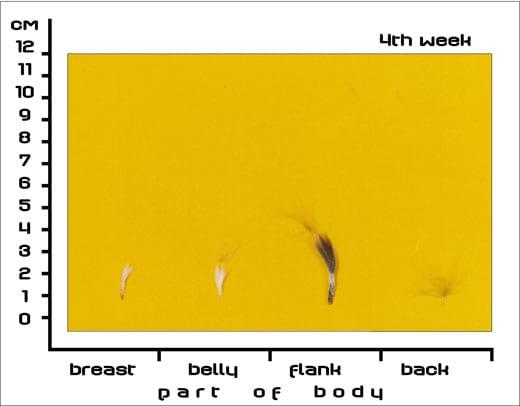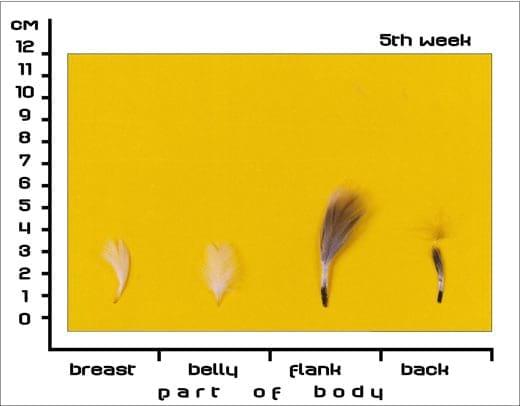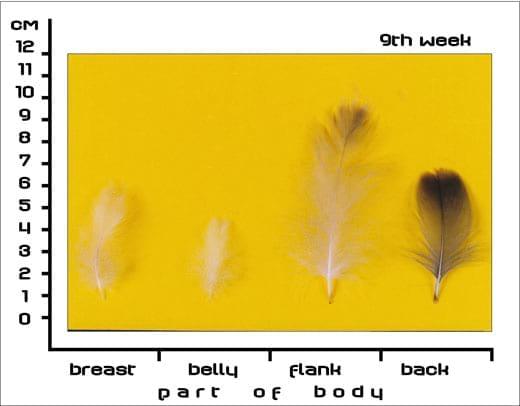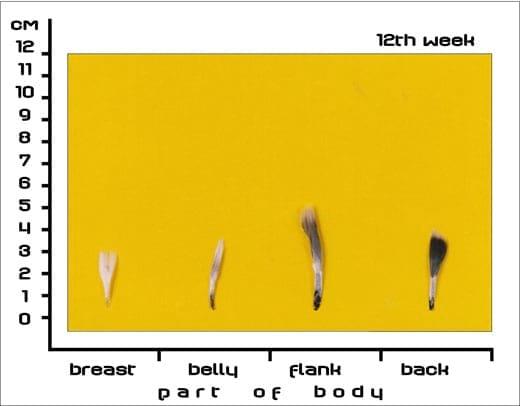Timing Feather Plucking to Natural Moult in Gray Landes Geese
Published: February 9, 2010
By: Kozák, J., Monostori, K., Karsai, M. and Pécsi, A
Abstract
Major phases of postnatal feather cycle were identified in Gray Landes Geese until 18 weeks of age so as to time the plucking process to the natural moult. These results with corresponding photos are made available here.
Introduction
Feathers and downs harvested from live geese are valuable raw materials and can be sold at a relatively high price.
Feathers can be harvested by manual plucking the geese. Though, this practise is frequently criticised for its apparent cruelty and prohibited in some member countries of the EU. Done properly, the plucking process is not painful since domestic fowls have a natural cycle of growth, maturation and moulting (shedding and renewing feathers). By timing the plucking process to coincide with the natural moult the feathers and downs are easy to harvest.
In Hungary puckling of live geese is a traditional activity, taking advantage of the natural moulting character of waterfowls. Moreover, manual or by licensed technology completed plucking of the mature feathers is approved by the Hungarian Animal Protection Act (1998).
We have studied major phases of feather cycle (moult, growth, maturation) in growing Gray Landes Geese so as to time the plucking process to the natural moult.
Materials and Method
Weekly feather samples were collected from 20 purebred Grey Landes Geese reared at the Goose Breeding Research Station (Gödöllő University) beginning from 3-4 weeks of age. On sampling occasions, 5-5 feather samples were taken from 4 body parts (breast, belly, flank, and back) of each bird.
Feathers representing best the average sample were selected and photographed on a squared paper to indicate feather length.
Results
Following is a description of major phases of feather cycle in growing Gray Landes Geese with a special reference to moult. Photographic depiction of the phases is given in Fig. 1.
The first, postnatal moult occurs in goslings between 3-4 weeks of age depending upon the body part, when most of the natal downs are replaced by feathers. The new cover feathers are intensively growing between 4-8 weeks of age and they become fully mature in all 4 body parts by the end of 11 week of age.
After feathers attained their maturity, a second (post-juvenile) moult is initiated. During this long-lasting natural moult, the shedding of "dead" feathers and downs can be enhanced by manual plucking that we performed on geese at the end of 11 week of age.
At 12 week of age (after plucking), all body parts are covered with rather immature feathers of small-sized quills. They undergo an intense growth between 12-16 weeks of age, followed by a phase of maturation between 17-18 weeks of age. By the end of 18 week of age the feathers in all 4 body parts again attain full maturity, enabling another plucking.
Subsequently, a series of sequential moulting occurs at about 6-7 week intervals in growing geese enabling additional plucking.
Conclusion
Puckling of live geese can be performed on growing geese provided that feathers are fully mature and the foot of the calamus is closed, free of blood and easy to remove.
The first plucking can be done on young geese at the end of 11 weeks of age, when their mature down feathers together with the other soft feathers, moult naturally.
Growing geese can then be plucked at approximately every 6-7 weeks as this will coincide with each successive moult.
Fig. 1: Photographic depiction of feather phases in growing Gray Landes Geese
Major phases of postnatal feather cycle were identified in Gray Landes Geese until 18 weeks of age so as to time the plucking process to the natural moult. These results with corresponding photos are made available here.
Introduction
Feathers and downs harvested from live geese are valuable raw materials and can be sold at a relatively high price.
Feathers can be harvested by manual plucking the geese. Though, this practise is frequently criticised for its apparent cruelty and prohibited in some member countries of the EU. Done properly, the plucking process is not painful since domestic fowls have a natural cycle of growth, maturation and moulting (shedding and renewing feathers). By timing the plucking process to coincide with the natural moult the feathers and downs are easy to harvest.
In Hungary puckling of live geese is a traditional activity, taking advantage of the natural moulting character of waterfowls. Moreover, manual or by licensed technology completed plucking of the mature feathers is approved by the Hungarian Animal Protection Act (1998).
We have studied major phases of feather cycle (moult, growth, maturation) in growing Gray Landes Geese so as to time the plucking process to the natural moult.
Materials and Method
Weekly feather samples were collected from 20 purebred Grey Landes Geese reared at the Goose Breeding Research Station (Gödöllő University) beginning from 3-4 weeks of age. On sampling occasions, 5-5 feather samples were taken from 4 body parts (breast, belly, flank, and back) of each bird.
Feathers representing best the average sample were selected and photographed on a squared paper to indicate feather length.
Results
Following is a description of major phases of feather cycle in growing Gray Landes Geese with a special reference to moult. Photographic depiction of the phases is given in Fig. 1.
The first, postnatal moult occurs in goslings between 3-4 weeks of age depending upon the body part, when most of the natal downs are replaced by feathers. The new cover feathers are intensively growing between 4-8 weeks of age and they become fully mature in all 4 body parts by the end of 11 week of age.
After feathers attained their maturity, a second (post-juvenile) moult is initiated. During this long-lasting natural moult, the shedding of "dead" feathers and downs can be enhanced by manual plucking that we performed on geese at the end of 11 week of age.
At 12 week of age (after plucking), all body parts are covered with rather immature feathers of small-sized quills. They undergo an intense growth between 12-16 weeks of age, followed by a phase of maturation between 17-18 weeks of age. By the end of 18 week of age the feathers in all 4 body parts again attain full maturity, enabling another plucking.
Subsequently, a series of sequential moulting occurs at about 6-7 week intervals in growing geese enabling additional plucking.
Conclusion
Puckling of live geese can be performed on growing geese provided that feathers are fully mature and the foot of the calamus is closed, free of blood and easy to remove.
The first plucking can be done on young geese at the end of 11 weeks of age, when their mature down feathers together with the other soft feathers, moult naturally.
Growing geese can then be plucked at approximately every 6-7 weeks as this will coincide with each successive moult.
Fig. 1: Photographic depiction of feather phases in growing Gray Landes Geese

Photo l: The body of day old goslings is covered by natal down.

Photo 2: The first, postnatal moult begins on the belly and the breast.

Photo 3: The feathers grow in the same papillae, the new follicles are formed under the old ones.

Photo4: The new cover feathers are intensively growing. The latest moult occurs on the mid part of the back at 5 week of age.

Photo5: The belly feathers are already mature, whilst feathers on the back are still immature.

Photo6: By the end of 11 week of age feathers in all 4 body parts attain maturity: the transparent quills situated loosely in the skin are easy to remove without any injury to the skin. Manual plucking (I) was performed on young geese at this time.

Photo7: All body parts are covered with immature feathers of small-sized quills.

Photo 8: These feathers undergo an intense development between 12-16 weeks of age.

Photo 9: By the end of 18 week of age feathers in all 4 body parts become again mature. Manual plucking (II) was performed on geese at this time.
Authors:
Join to be able to comment.
Once you join Engormix, you will be able to participate in all content and forums.
* Required information
Would you like to discuss another topic? Create a new post to engage with experts in the community.
Create a post






